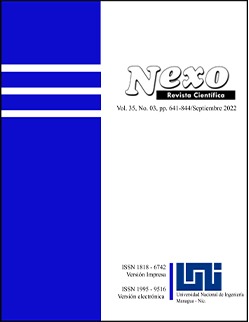Desarrollo de tecnología innovadora para el procesamiento de materias primas secundarias en la industria cárnica
DOI:
https://doi.org/10.5377/nexo.v35i03.15005Palabras clave:
concentración a baja temperatura, materia prima secundaria, sangre de cerdoResumen
La sangre de los animales sacrificados es una valiosa materia prima secundaria en la industria cárnica. En esta investigación, proponemos una tecnología de congelación de separación para la concentración de sangre, plasma sanguíneo y solución de hemoglobina. Se estudiaron los procesos de congelación de separación de materias primas cárnicas secundarias para lo cual se realizaron los experimentos de congelación en un cristalizador capacitivo. Se determina la dependencia de la duración de la congelación con la temperatura de la superficie de intercambio de calor y se calcula el criterio de eficiencia de la crioconcentración. Se demuestra que la mayor eficiencia de congelación se observa a la temperatura de la superficie de intercambio de calor de menos 2°C. A esta temperatura se observó la menor pérdida de materia seca. Se realizó el experimento de separación por liofilización de una solución de hemoglobina con el uso de recrioconcentración. Se establece que esta tecnología puede reducir significativamente la pérdida de materia seca. Se realizó el análisis de plasma de sangre de cerdo antes y después de la cristalización. Se encontró que la cristalización casi no tiene efecto sobre la cantidad y proporción de aminoácidos en el producto.
Descargas
1570
Descargas
Publicado
Cómo citar
Número
Sección
Licencia
Derechos de autor 2022 Universidad Nacional de Ingeniería

Esta obra está bajo una licencia internacional Creative Commons Atribución 4.0.
Los autores que publican en Nexo Revista Científica están de acuerdo con los siguientes términos:
- Los autores conservan los derechos de autor y conceden a la revista el derecho de la primera publicación bajo la licencia Creative Commons Attribution License, que permite a otros compartir el trabajo con un reconocimiento a la autoría de la obra y a la publicación inicial en Nexo Revista Científica.
- Los autores pueden establecer por separado acuerdos adicionales para la distribución no exclusiva de la versión de la obra publicada en la revista (por ejemplo, en un repositorio institucional o en un libro) con el reconocimiento de su publicación inicial en Nexo Revista Científica.
- Se permite y se anima a los autores a difundir sus trabajos electrónicamente (por ejemplo, en repositorios institucionales o en su propio sitio web) antes y durante el proceso de envío, ya que puede dar lugar a intercambios productivos, así como a una citación más temprana y mayor de los trabajos publicados.










